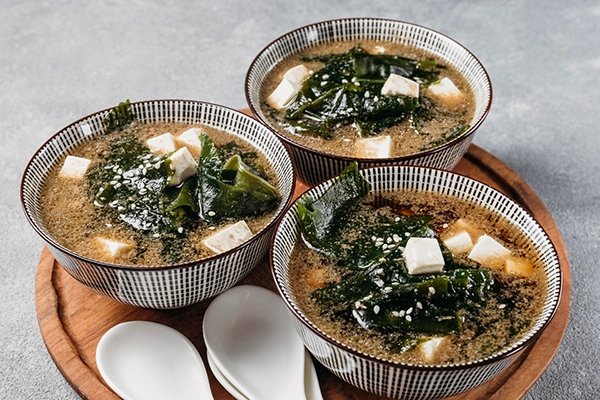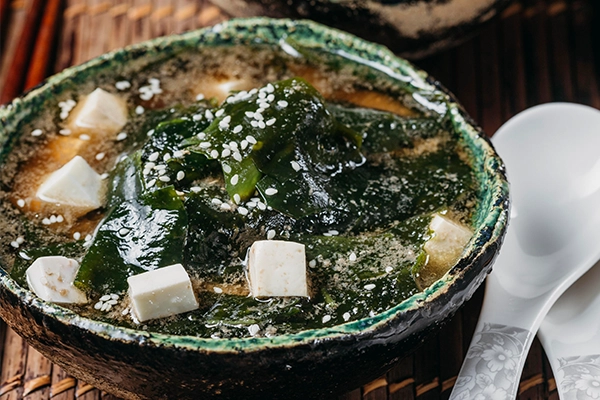Of all the dishes that have been able to make a special place in the culinary history of Japan, miso soup is one of the most iconic dishes. Simple yet extraordinary, this soup has been cherished for centuries not only in Japan but across the globe, where its unique flavors and nutritious qualities have won the hearts of many.
Miso soup is a gastronomic experience due to its velvety umami flavors and light texture. It is not only delicious but also a healthy and satisfying addition to modern dietary preferences. In the following article, we look into the history and preparation of miso soup in detail, covering its ingredients, cooking steps, and some tips to enhance its taste. At the end, we’ll also introduce a special suggestion for sourcing high-quality ingredients from Faraz Hypermarket.
What is Miso Soup?
Miso soup is one of Japan’s most celebrated traditional dishes, made from a simple yet flavorful combination of miso paste (fermented soybean paste) and dashi (a light Japanese stock). This soup plays an essential role in Japanese dining culture, appearing in meals from breakfast to dinner.
The uniqueness of miso soup comes from its complex, soothing flavor-the miso itself, combining with other ingredients like tofu and wakame or seaweed. This distinctive flavor profile, together with its nourishing qualities, turns the soup into a favorite in Japan and all over the world.
Beyond its taste, miso soup is famous for its nutritional value. Rich in probiotics, vitamins, and minerals, it is an excellent choice for those who want to eat healthy and balanced. Its adaptability also adds to its popularity-you can customize it with vegetables, proteins, or other ingredients based on personal preferences.
This versatility ensures that miso soup is not only a staple in Japanese households but also a popular option on restaurant menus globally. Whether you are an experienced chef or a novice in the kitchen, miso soup is an accessible and rewarding dish to prepare.

Essential Ingredients
Preparing miso soup doesn’t require complicated ingredients, but the quality of the components greatly impacts the final result. Here’s what you’ll need to make a perfect bowl of miso soup:
• 2 tablespoons of miso paste: Available in white, yellow, or red varieties. White miso is milder and suitable for beginners, while red miso has a stronger and saltier flavor.
• 4 cups of dashi stock: It is the basic flavor for the soup. You can make dashi yourself by using katsuobushi (fermented bonito flakes) and kombu (seaweed), or use a ready-made dashi powder for your convenience.
• 100 grams cubed tofu: Provides a silky texture and neutral flavor that enhances the overall taste of the soup.
• 2 tablespoons of chopped green onions: It enhances the freshness, adding more beauty to the dish.
• One dried wakame seaweed: It reconstitutes to a tender texture and subtle sea flavor.
• Salt and pepper to taste: Seasoning and balancing the final flavor.
For an authentic Japanese taste, sourcing high-quality ingredients is vital. Faraz Hypermarket offers a wide range of premium miso paste, tofu, and wakame for an exceptional cooking experience.
Steps to Make Miso Soup
1. Preparing the Dashi Stock
The first step in making miso soup is preparing the dashi stock, which is the base of the flavor of the dish. Dashi can be made from scratch using katsuobushi and kombu. Just simmer these ingredients in water, then strain the mixture to get a flavorful, clear broth.
If you’re short on time, instant dashi powder is a convenient alternative. Mix the powder with warm water as per the package instructions. Heat the prepared dashi over medium heat, ensuring it stays warm without boiling excessively, as this can alter the delicate flavor.
2. Rehydrating Wakame
Dried wakame seaweed should be soaked in warm water for a few minutes to rehydrate. This simple step serves to ensure the wakame is tender to go into the soup later. 3. Dissolve the Miso Paste h3
First of all, mix the miso paste in advance so that there will not be any lumps of miso in the soup. Mix the miso paste in a small bowl with a ladleful of warm dashi until smooth. Adding miso to soup without dissolving it could cause a rough texture. What’s more, miso should never be added to boiling liquid; doing so can kill its valuable probiotics and ruin the sensitive flavor.
4. Combine Ingredients
Once the dashi is hot, gently whisk in the dissolved miso paste into the pot. Add cubed tofu and rehydrated wakame, and let them simmer gently for a few minutes. This allows the flavors to come together without breaking down the integrity of the tofu and seaweed.
5. Adding Green Onions and Seasoning
Sprinkle the chopped green onions into the soup in the last step. These add a great freshness and raise the appeal of the dish to another level. Season the soup with salt and pepper to taste, if needed.
6. Serving the Soup
Traditionally, miso soup is served warm in small bowls, which makes it perfect for serving as either a starter or as a light, nourishing meal. Its simplicity and elegance are fitting for any occasion, from casual family meals to formal occasions.
Pro Tips for the Perfect Miso Soup
• Select the Correct Miso Paste: The type of miso used plays a major role in your soup. White miso is mild and sweet; hence, it is suitable for beginners, while red miso offers a bolder, more complex taste.
• Make Dashi at Home: If possible, make dashi stock at home. This will give you a real authentic flavor. The effort will pay off in enhancing the taste and richness of your soup.
• Quality Wakame: Use nothing but high-quality wakame, whether dried or fresh, since the taste and nutritional value depend significantly on this ingredient.

Nutritional Value of Miso Soup
Well, miso soup isn’t only delicious but packed with nutrients, too:
• Miso Paste: Rich in probiotics that help with gut health and digestion.
• Wakame: Packed with minerals and vitamins, including iodine, calcium, and magnesium.
• Tofu: Laced with plant-based proteins and essential amino acids. Tofu is really great for vegetarians and vegans alike.
That makes this soup filling yet healthy, since it meets the dietary balance; for this reason, it must be one of the very smart health choices.
Conclusion
Miso soup is a great combination of flavors and nutrition, not to mention an insight into truly Japanese cuisine. Its ease of preparation and the depth of flavor and health benefits it provides make it a dish worth mastering.
For an enhanced cooking experience, try getting your ingredients from Faraz Hypermarket. They sell top-quality miso paste, tofu, wakame, and lots more that will give these dishes their authentic flavor. Now, go ahead and give this recipe a shot for a truly enjoyable taste of Japan. Bon appétit!










